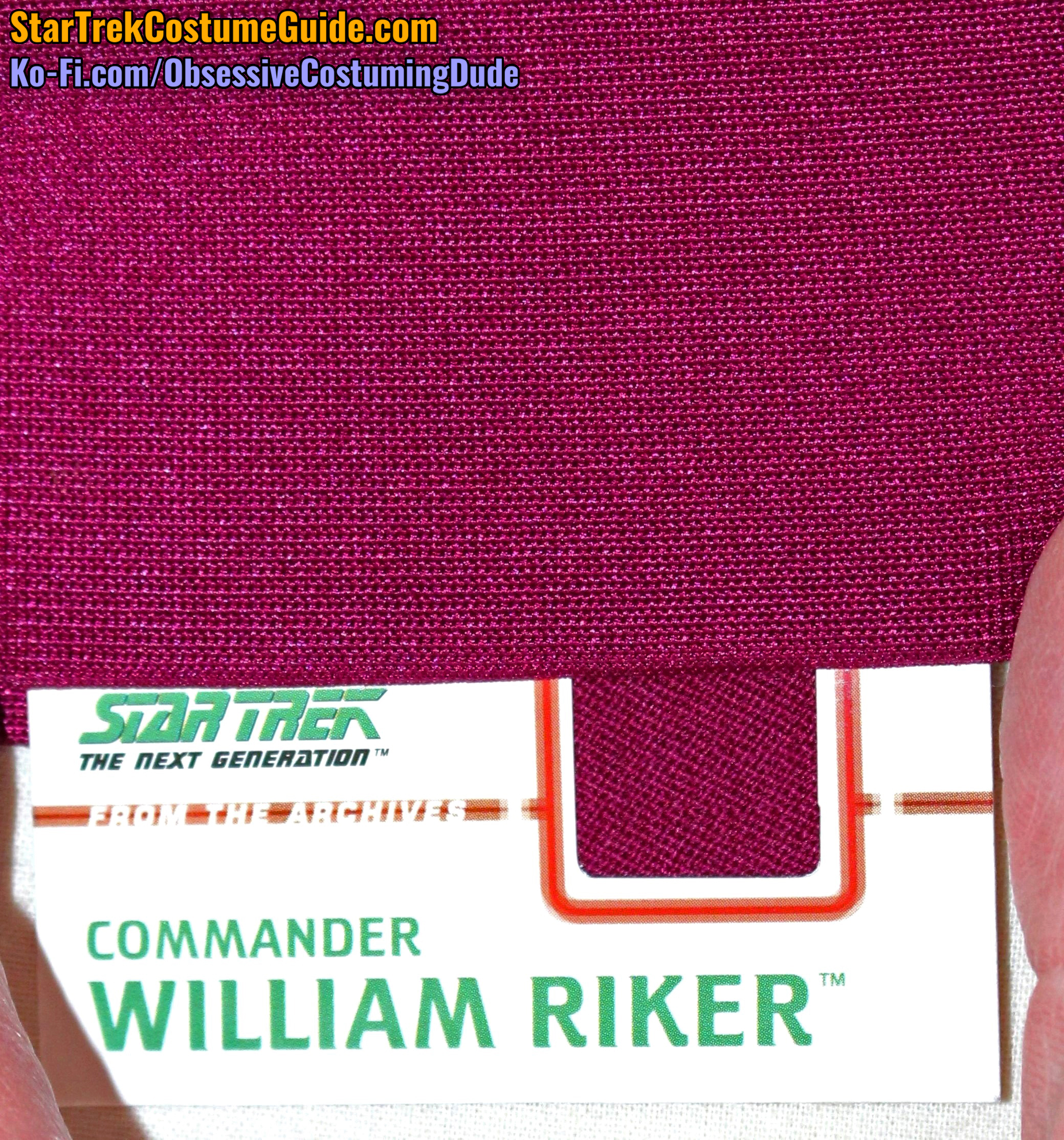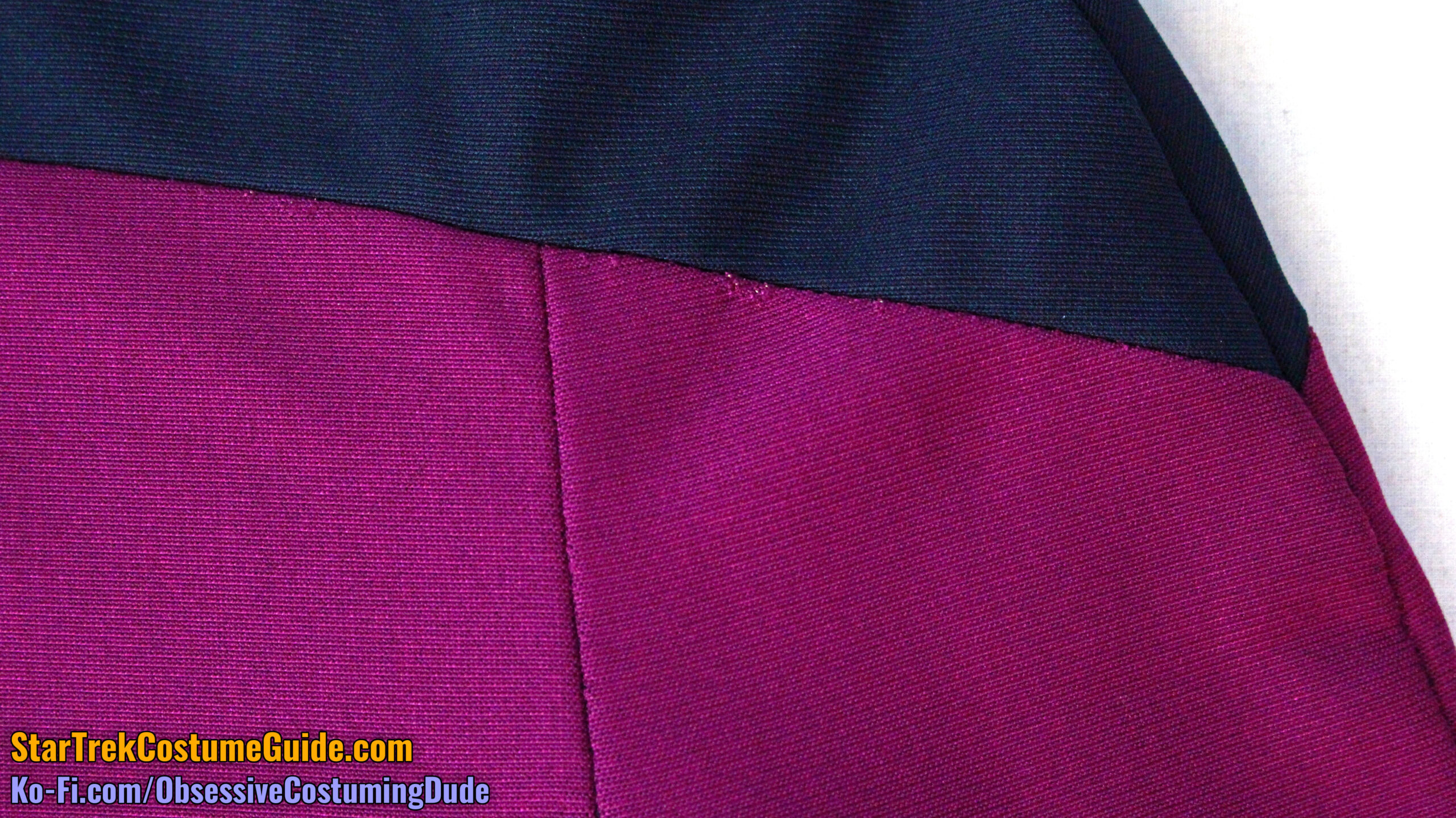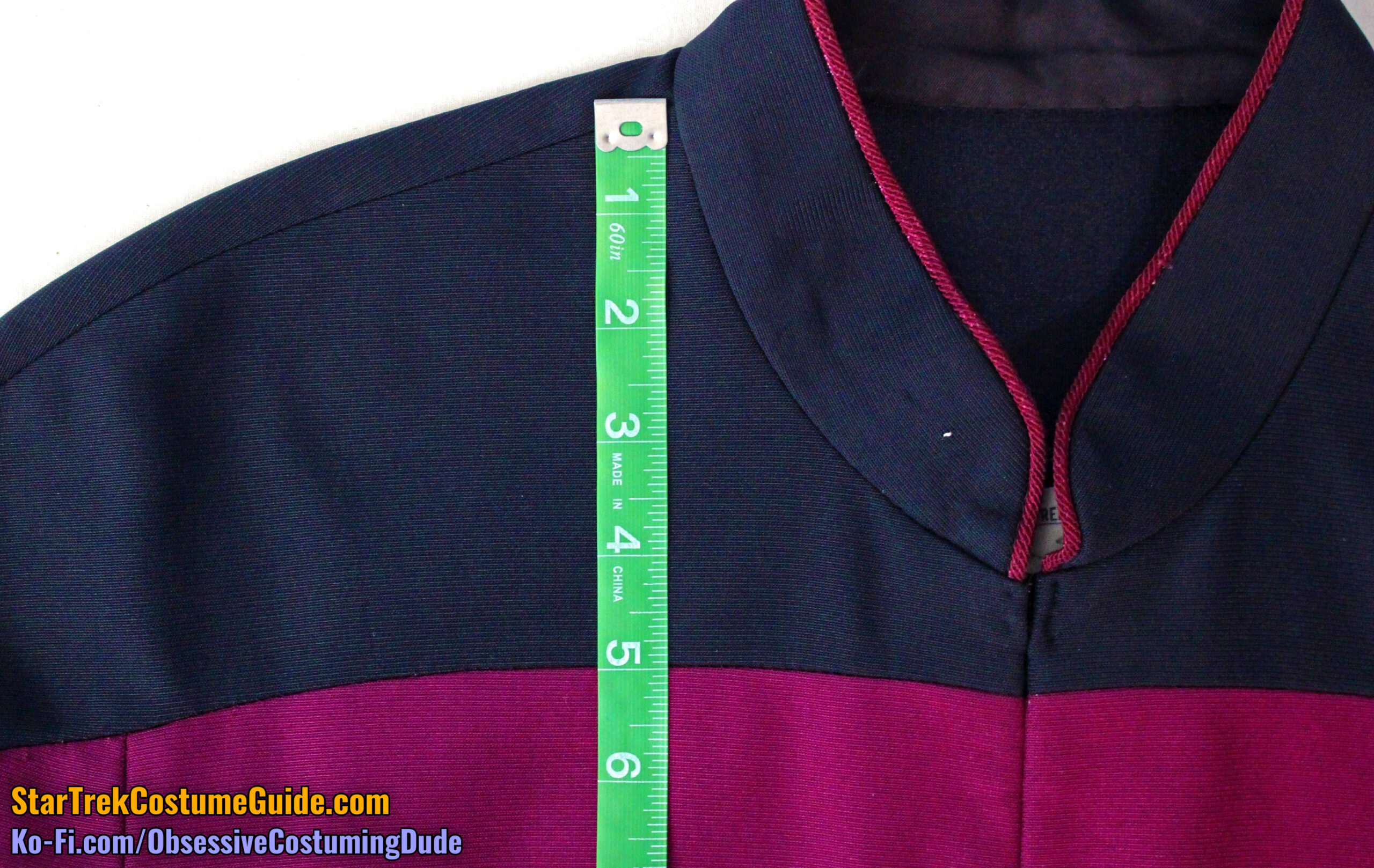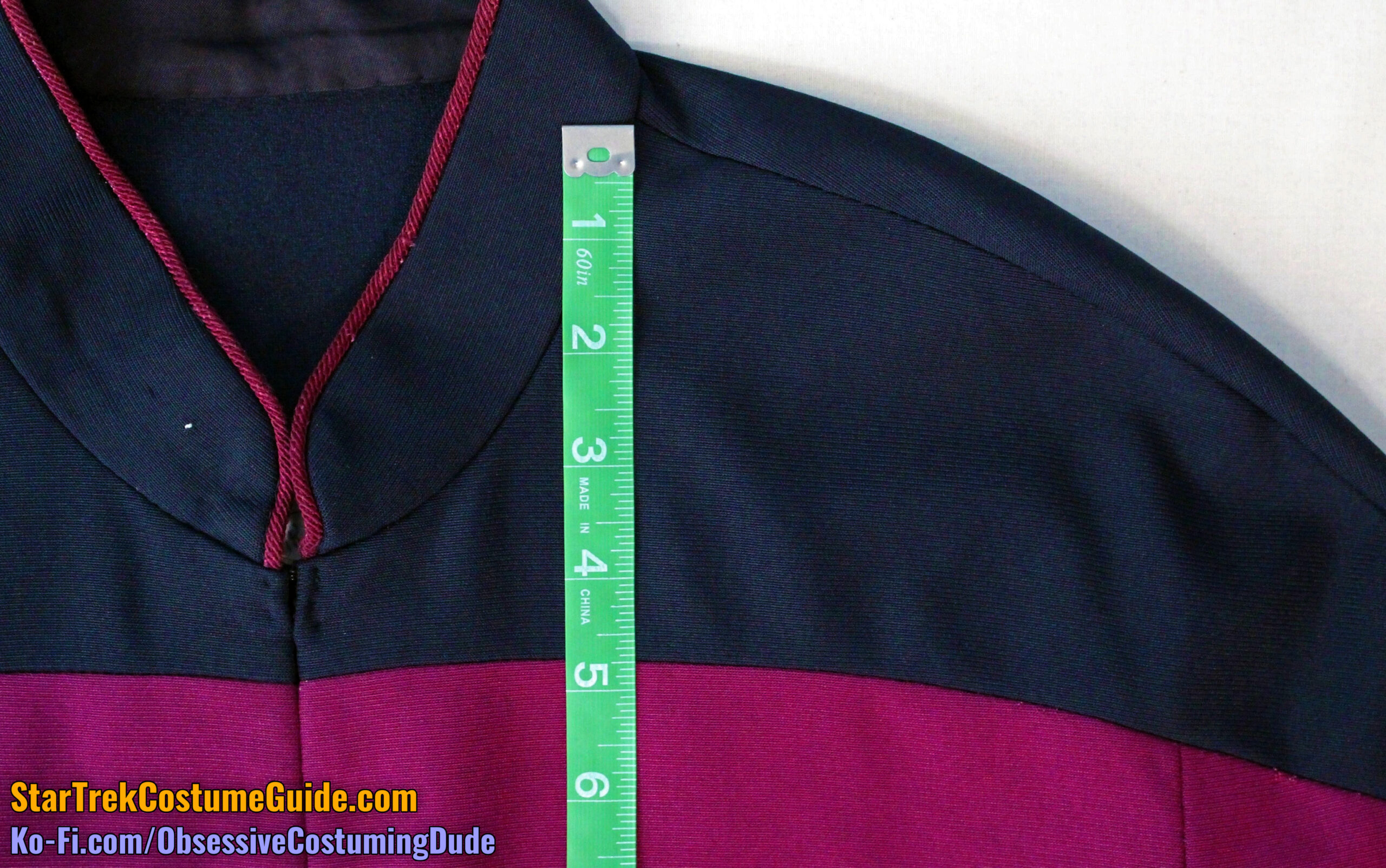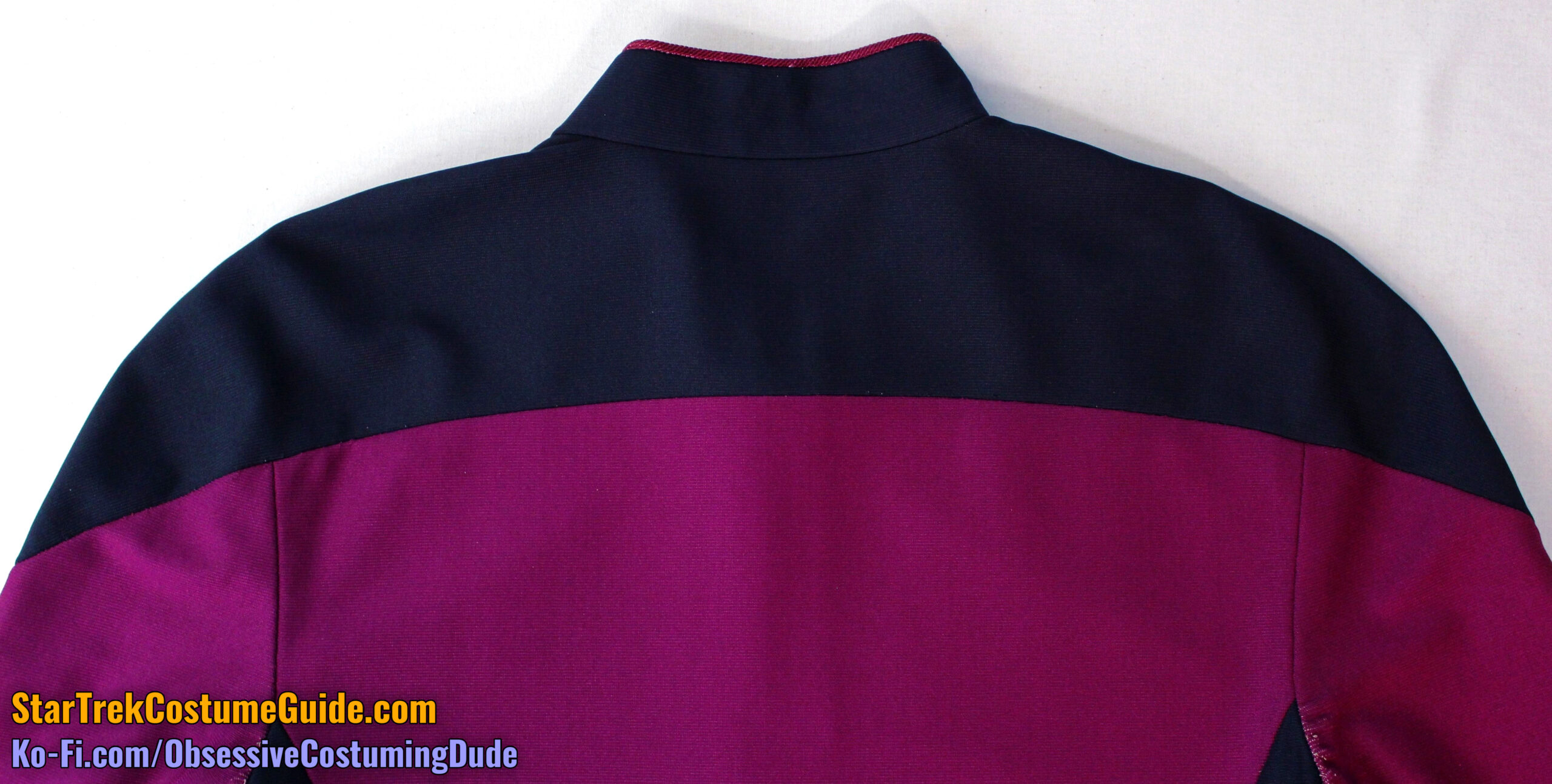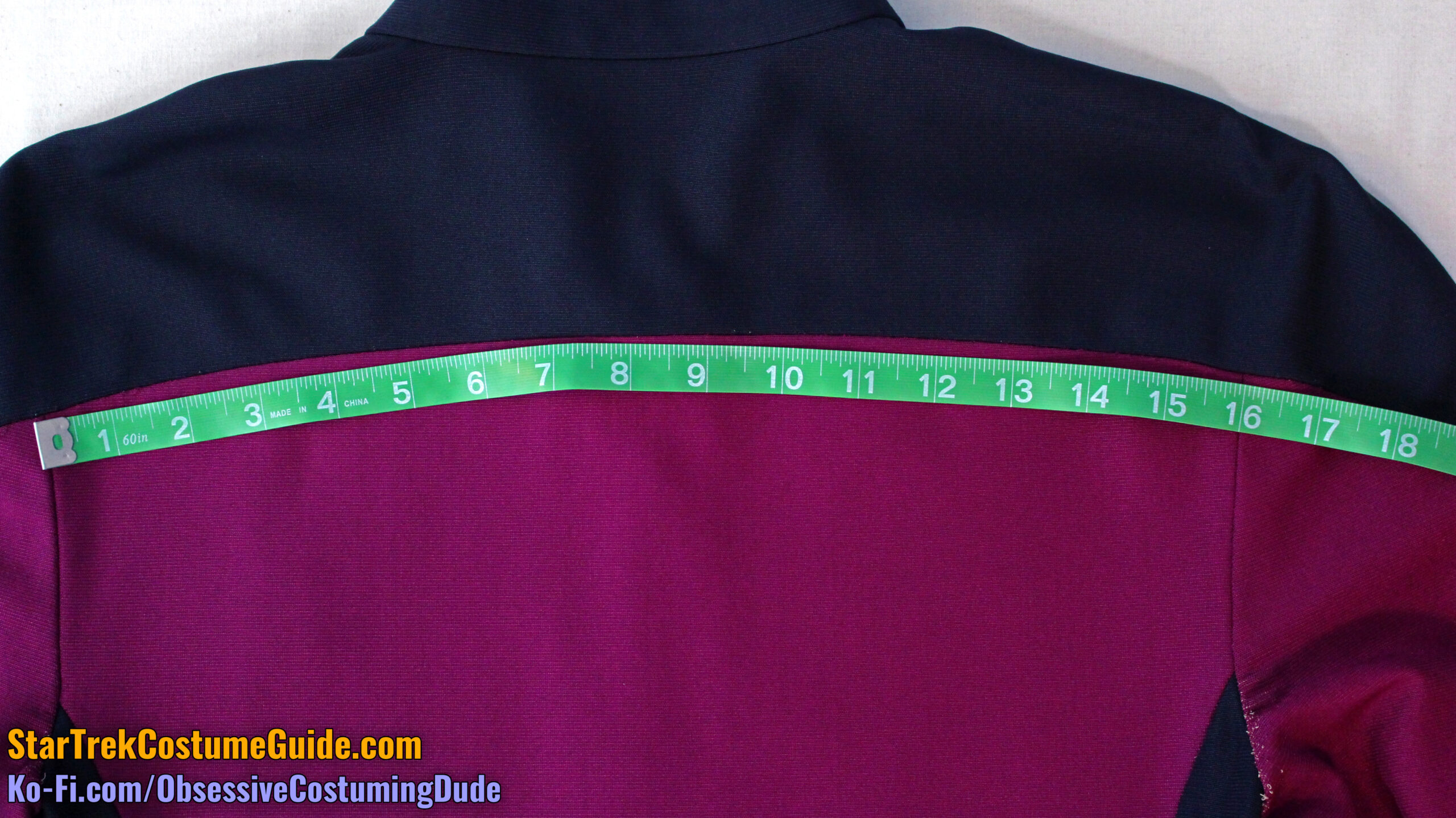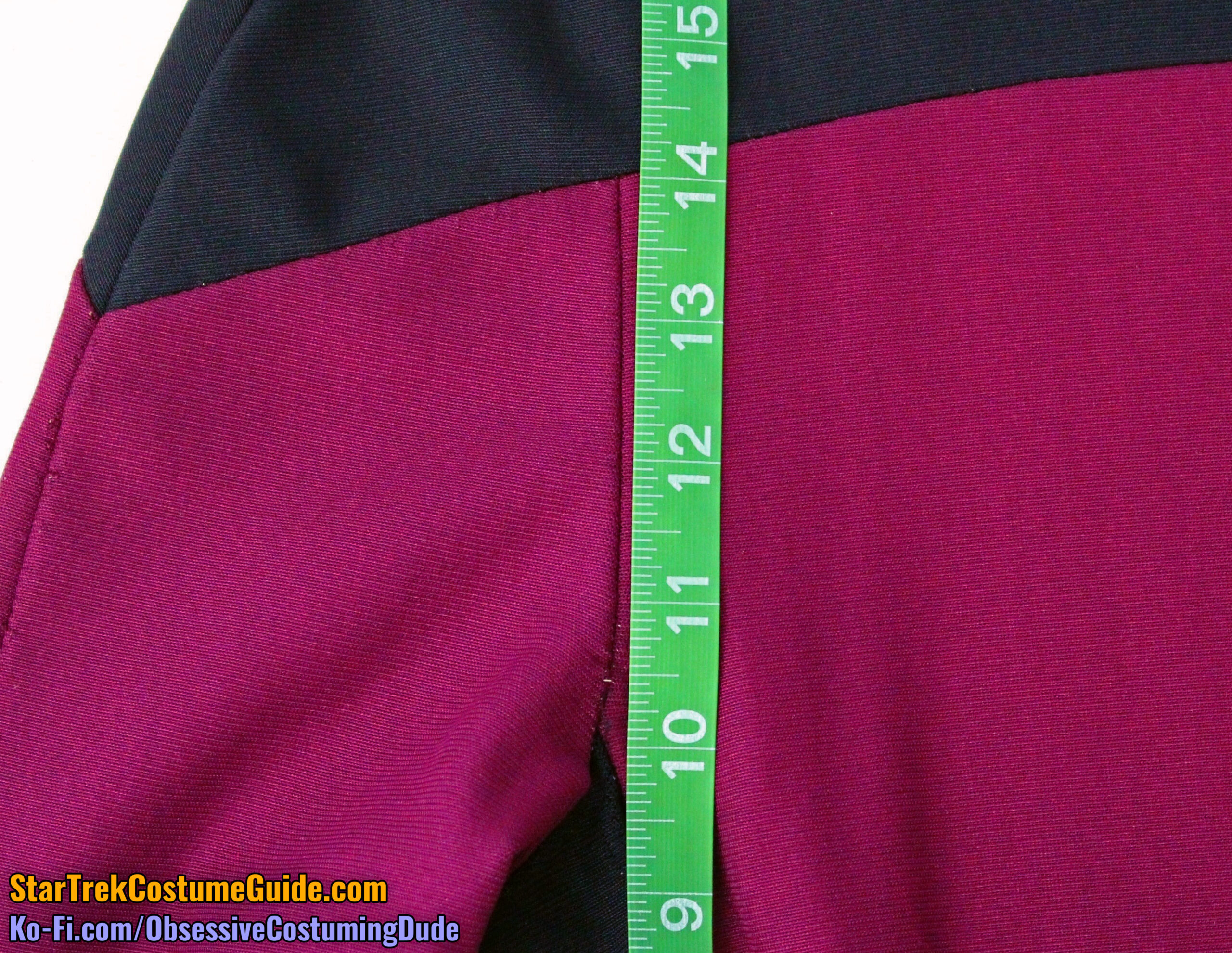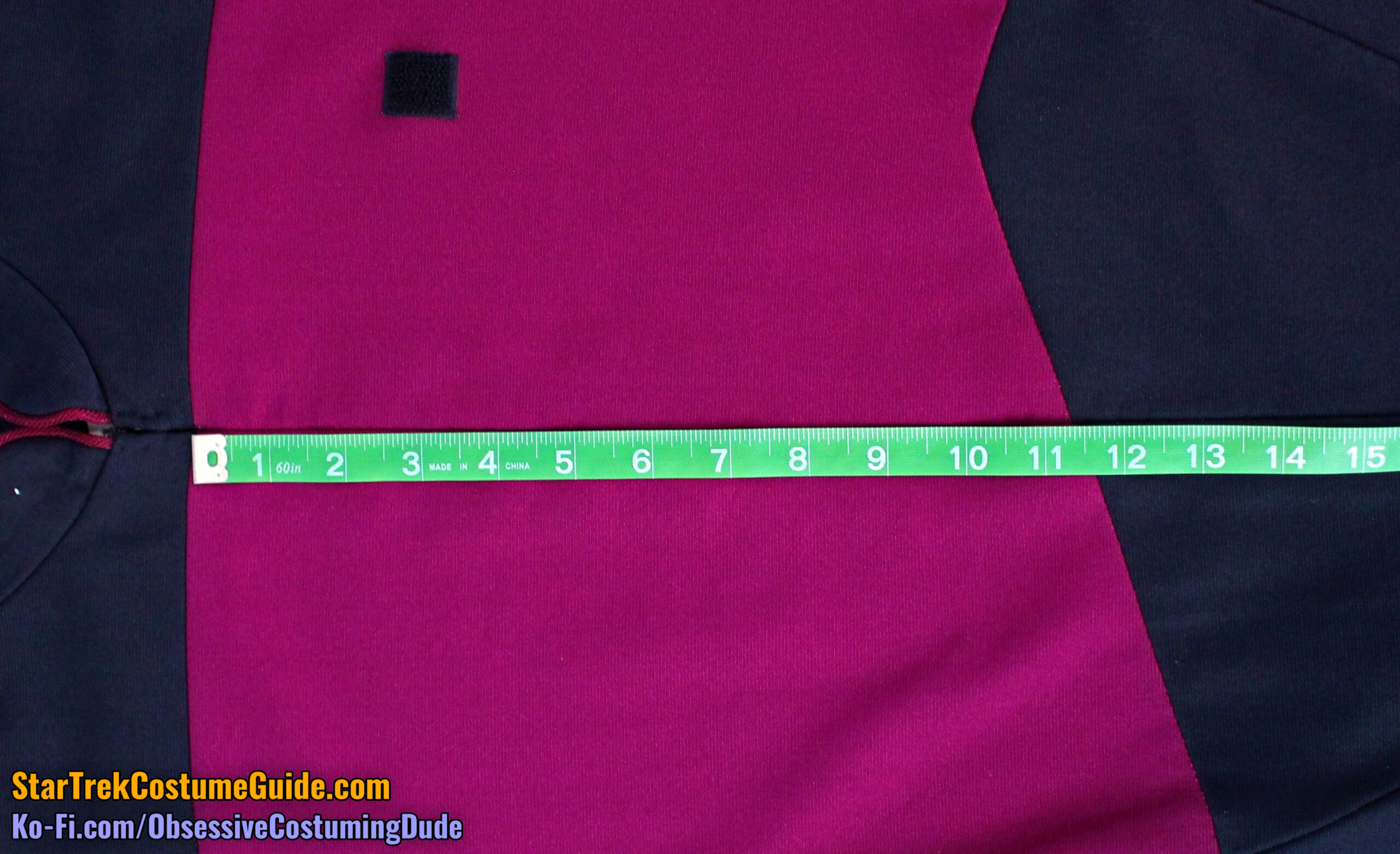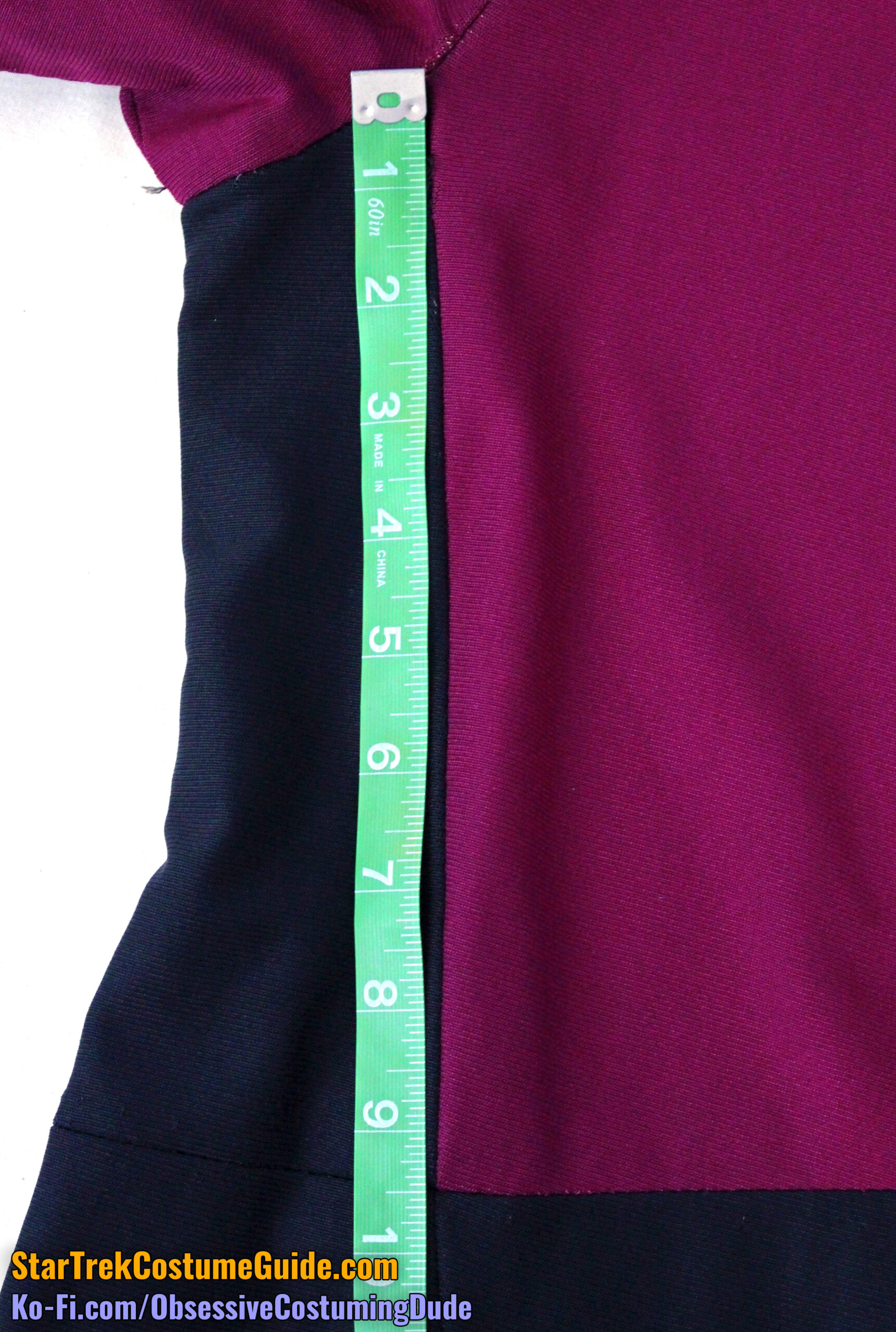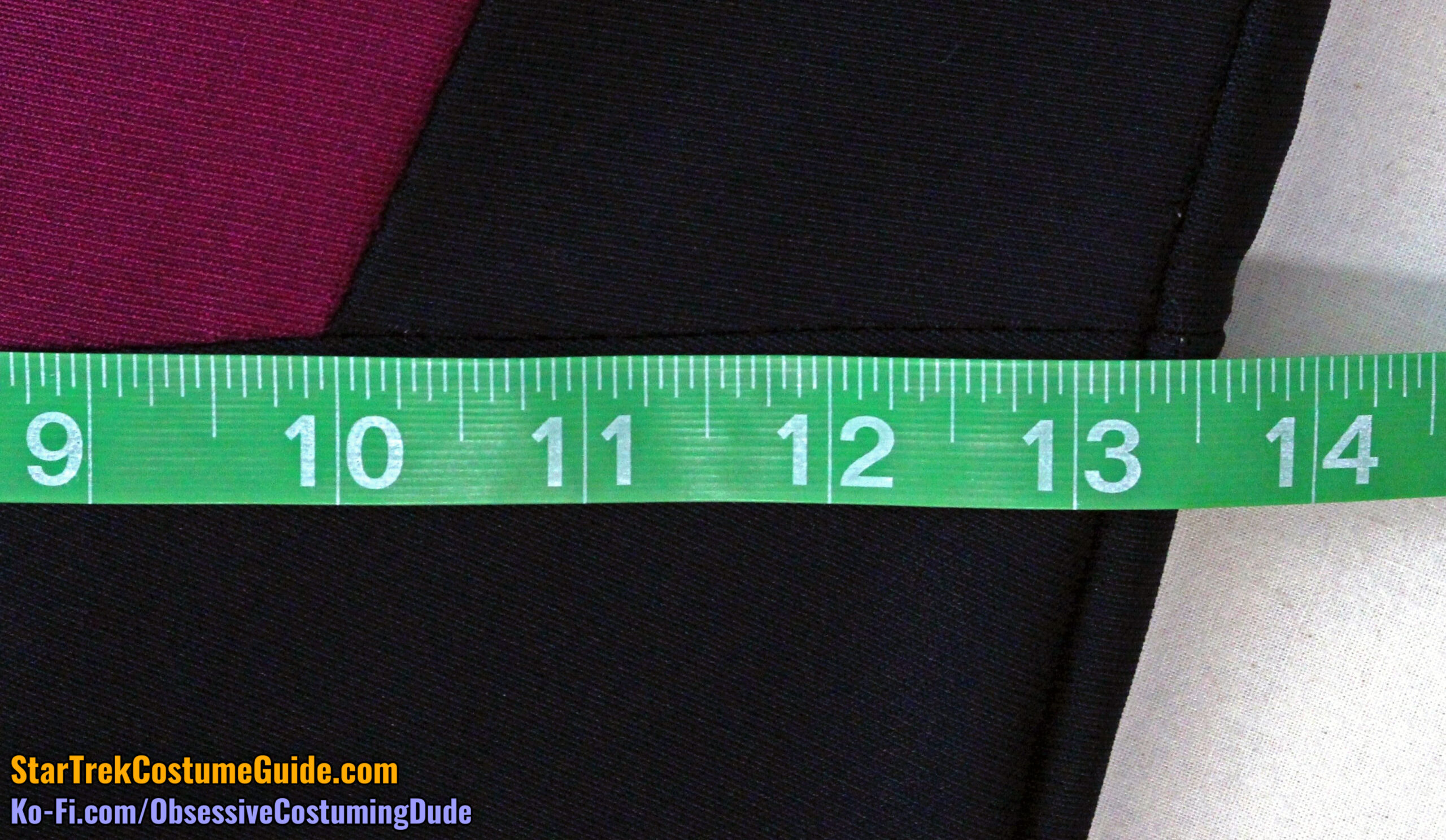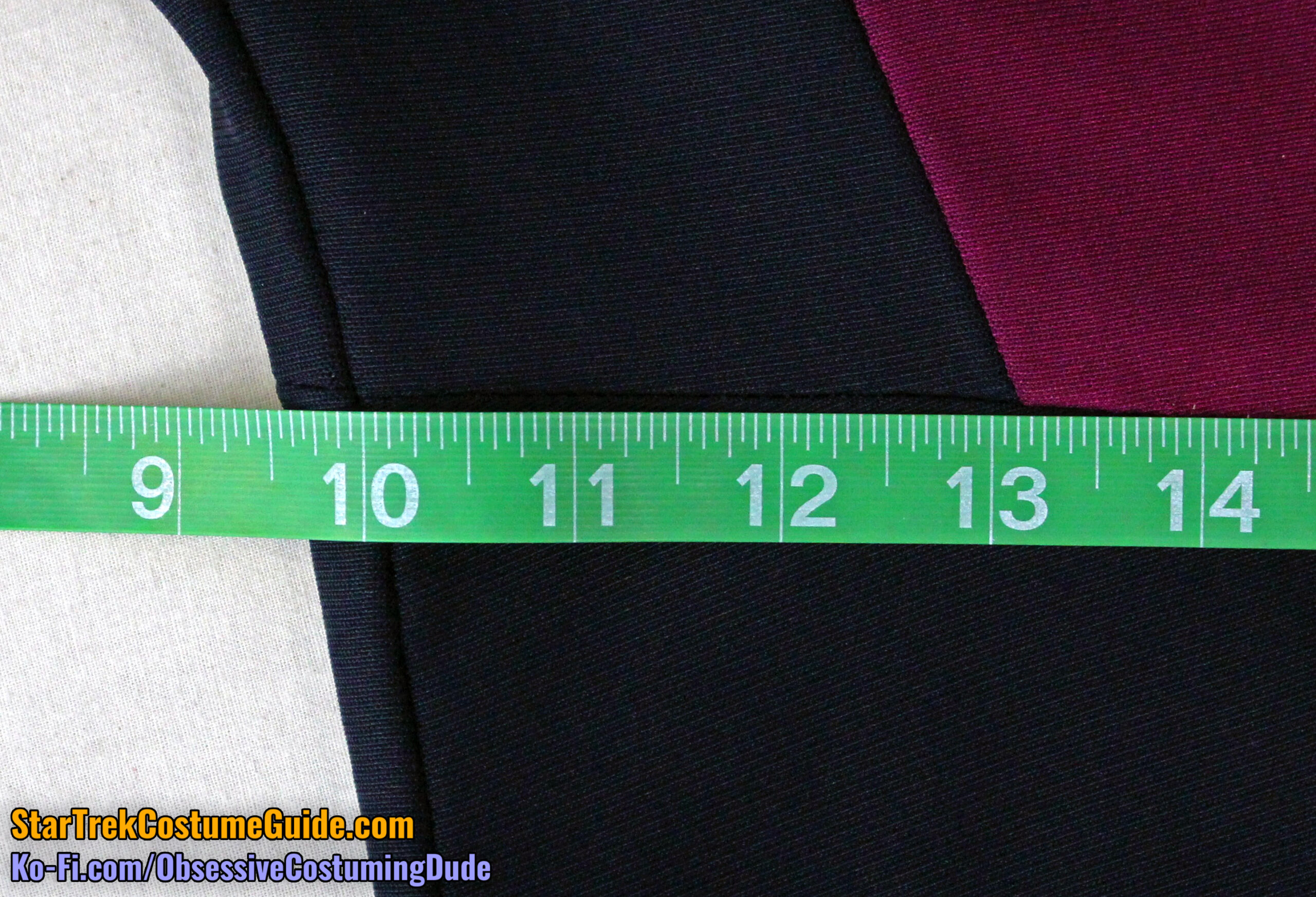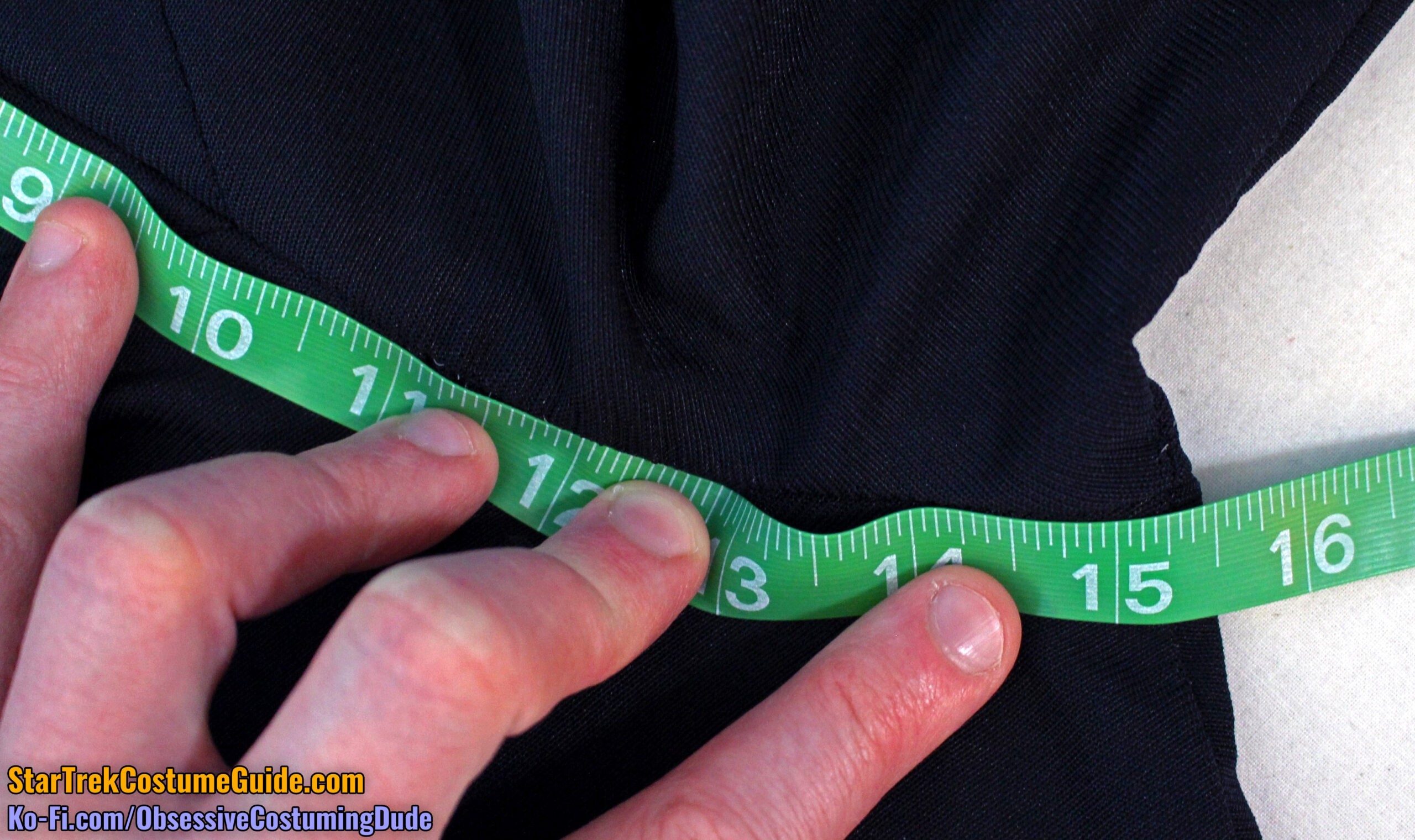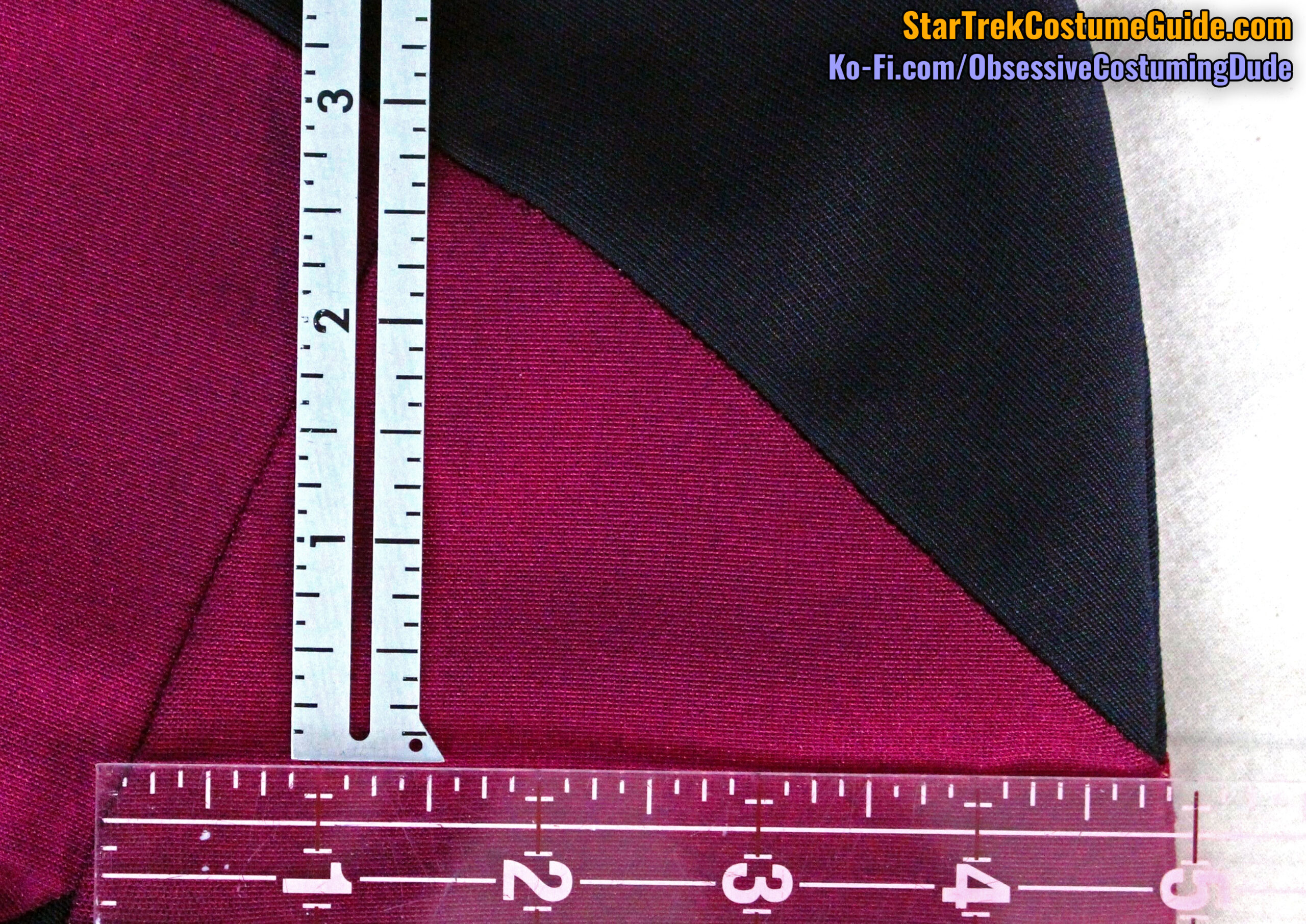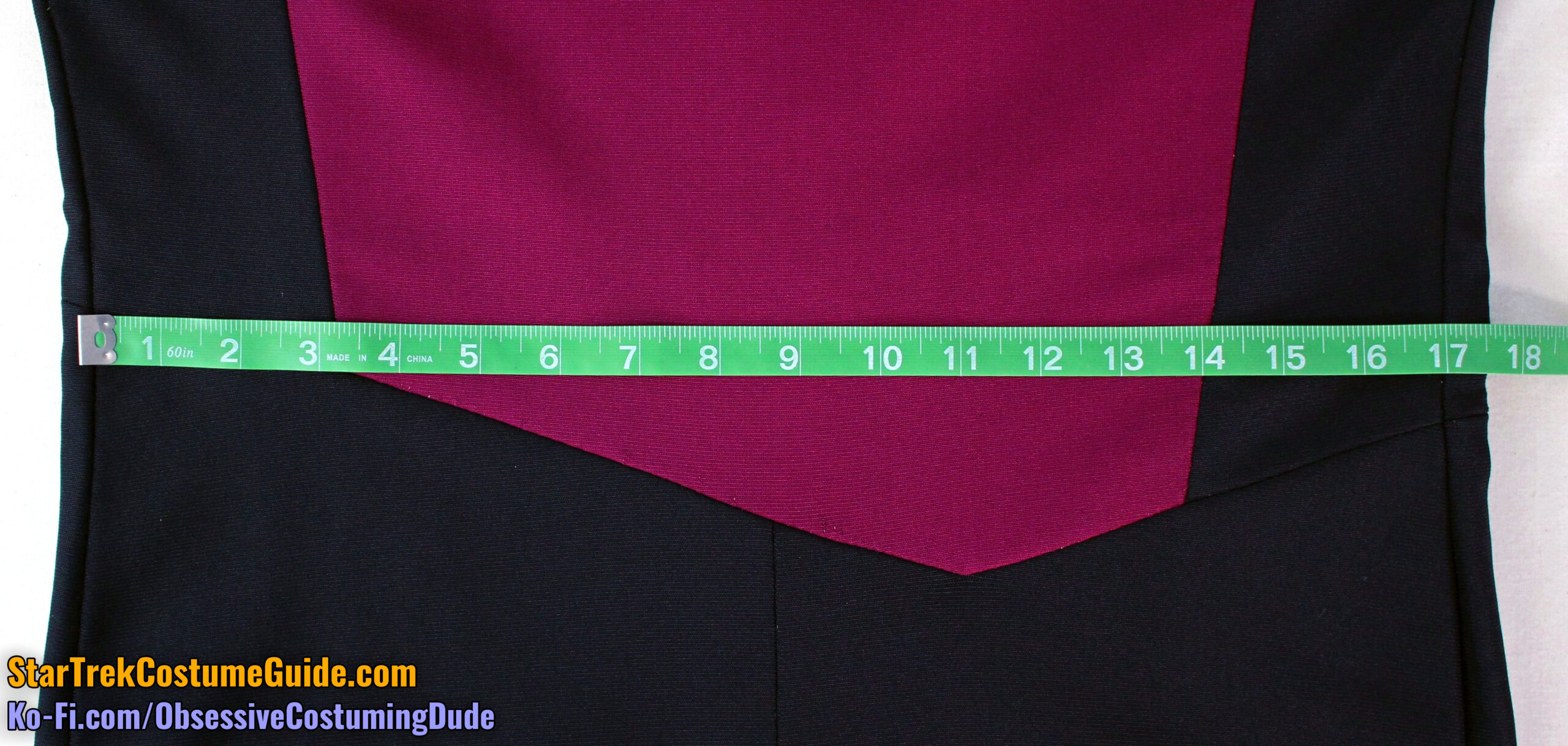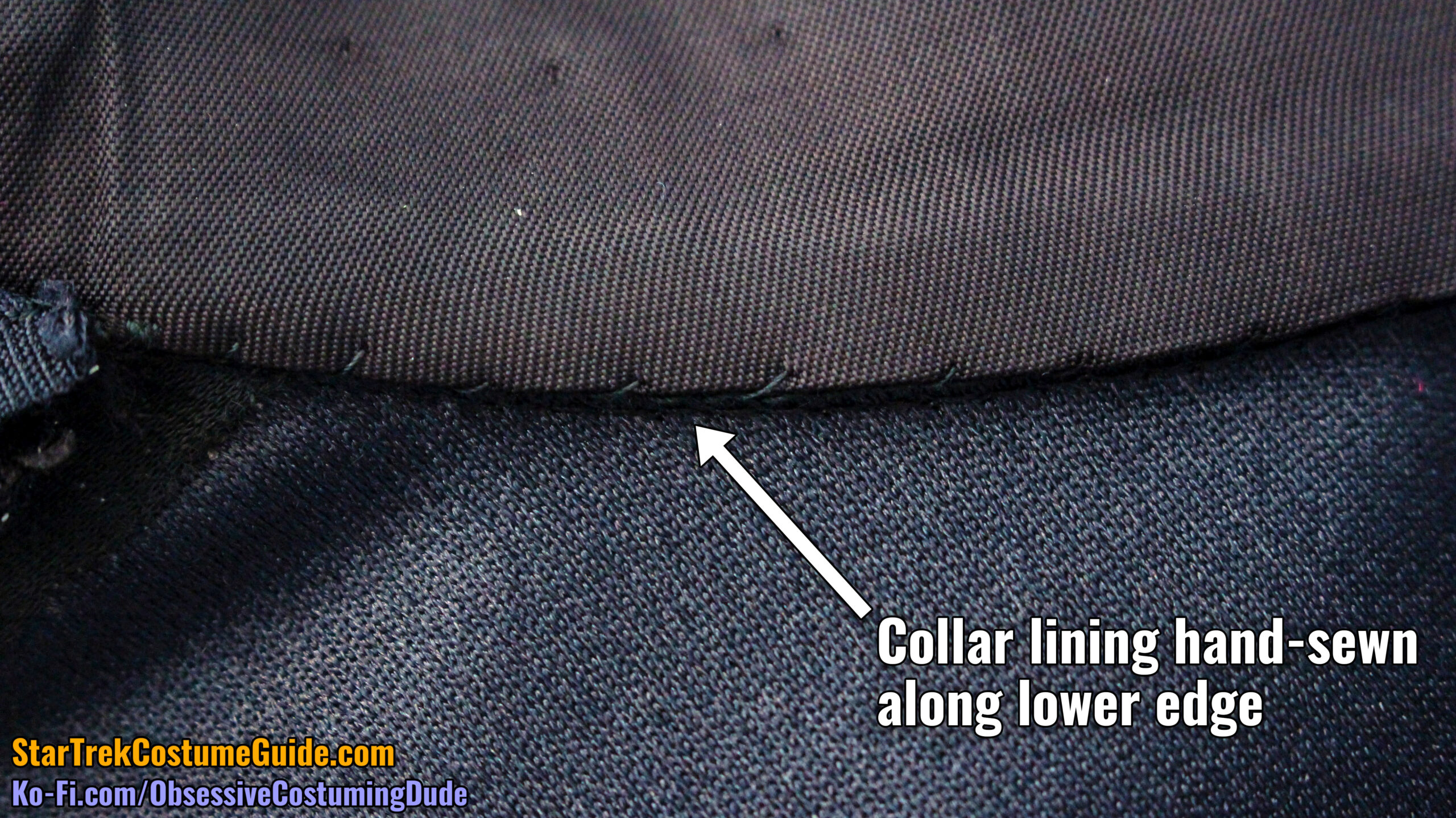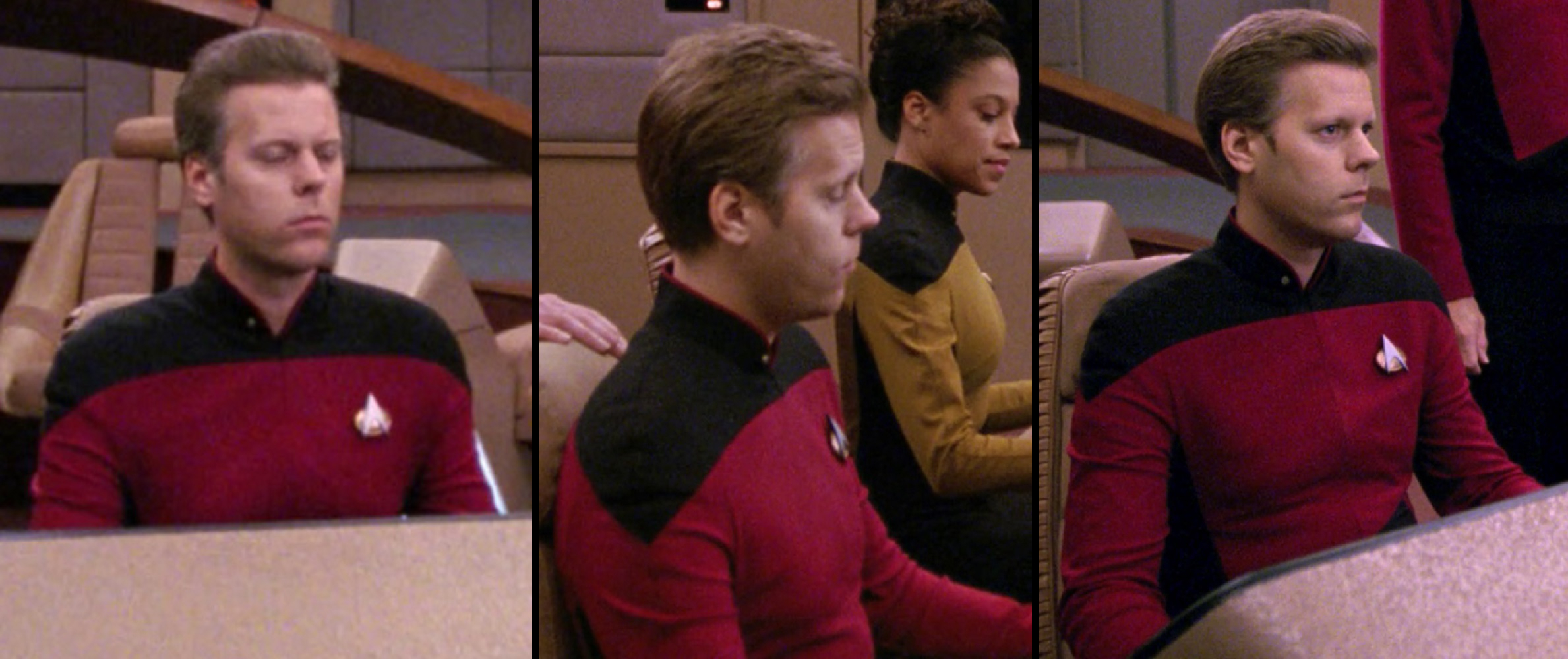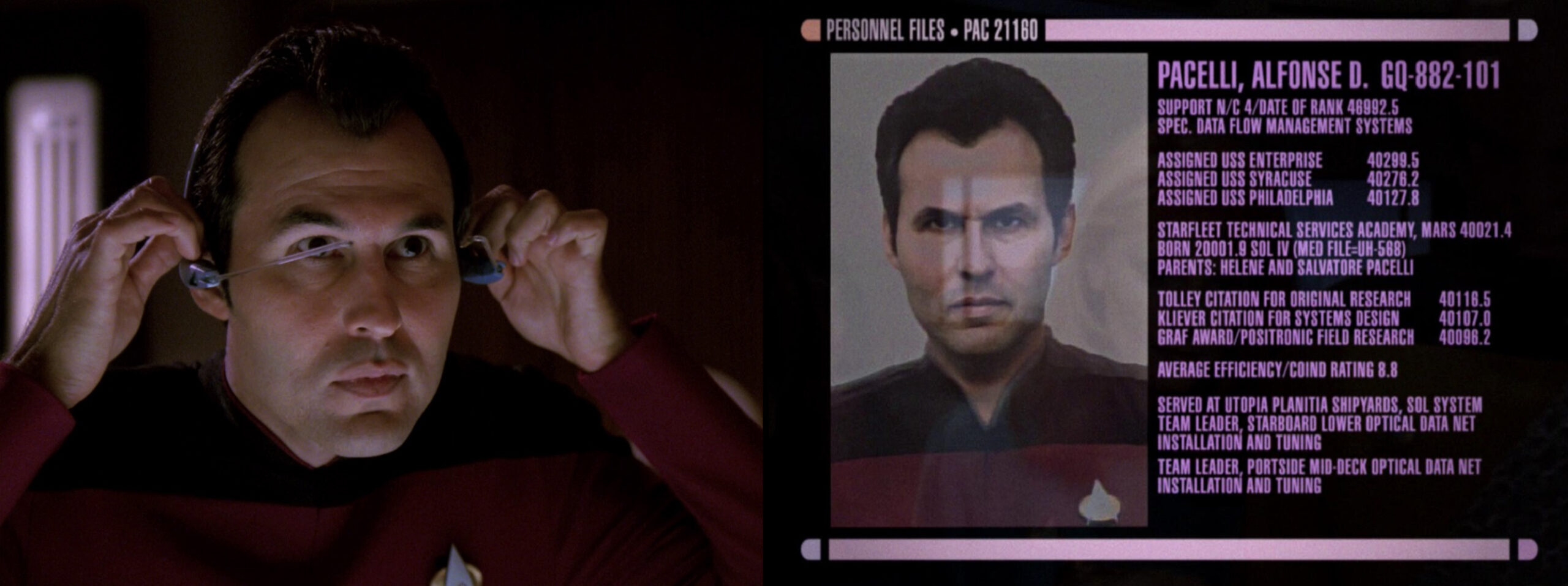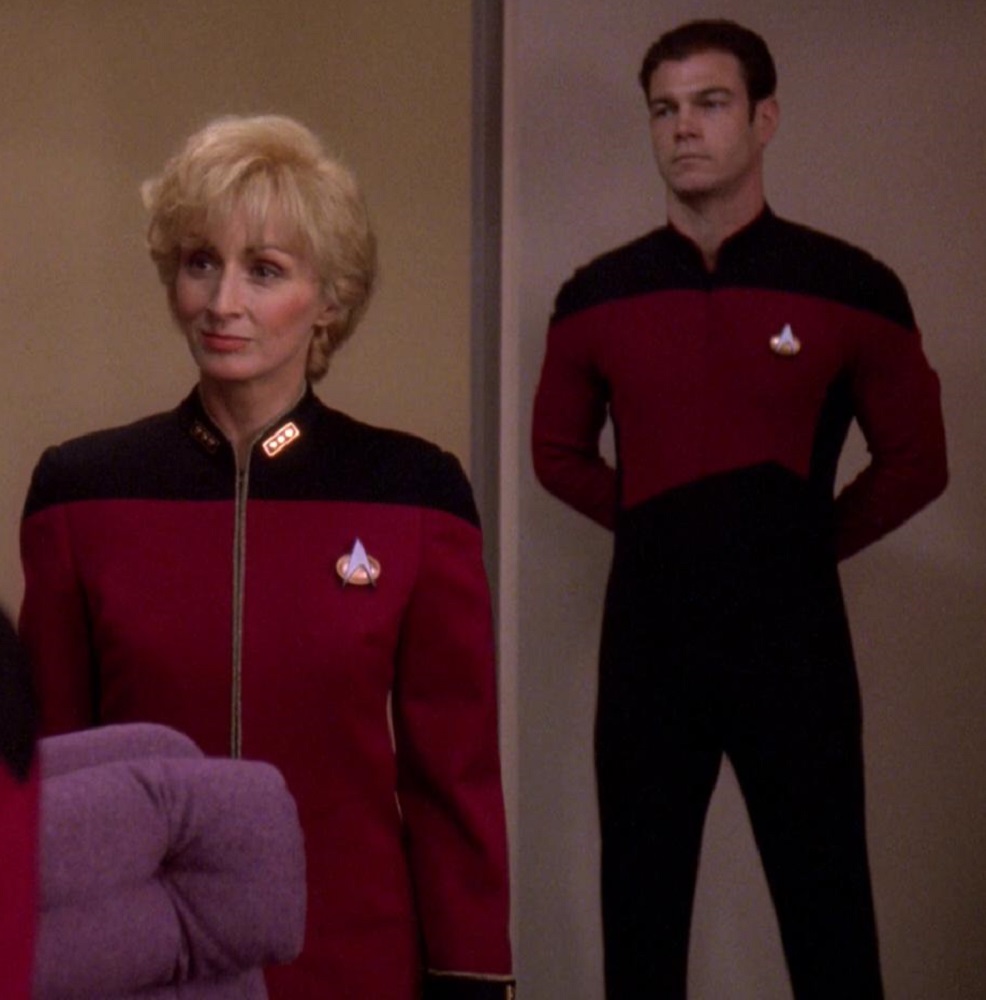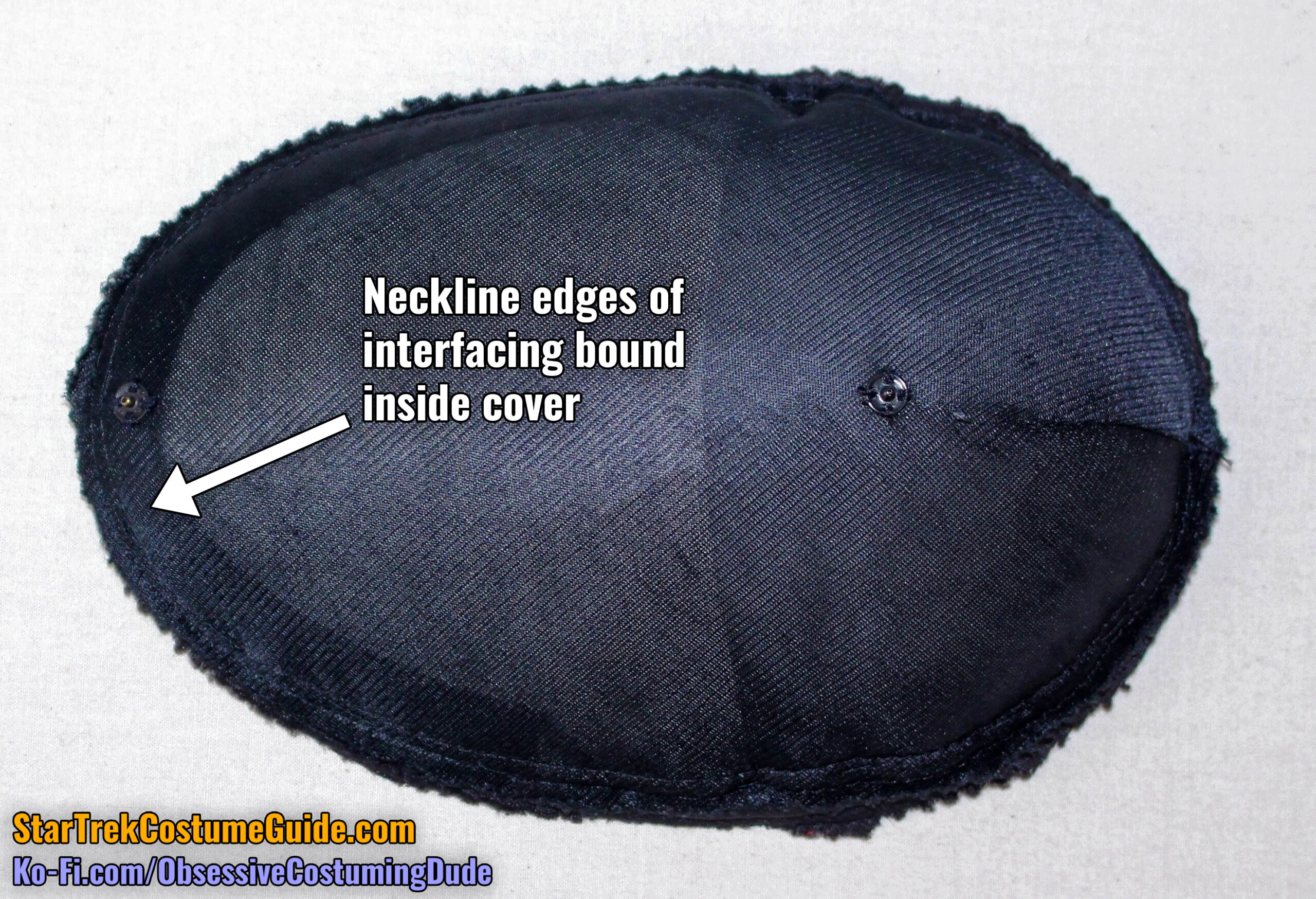This time we’ll be taking a look at a screen-used extra’s TNG jumpsuit from the later seasons – again courtesy of Star Trek collector extraordinaire Angelo Cifaldi. 🙂
This uniform has several interesting differences to all of the previous TNG jumpsuits I’ve recently posted about – most obviously, that it’s a front-zipping later-style uniform, which we haven’t looked at yet.
In this corresponding video, I discuss some of the highlights from the following post:
Special thanks to Angelo Cifaldi (owner of this costume) and to my Ko-Fi supporters for helping make this possible.

FABRIC COLOR and GRAIN
Like the other “red” uniforms I’ve examined, this jumpsuit often photographed as red but in-person the actual color is more of a purple-ish “berry.”
While close to the color of the screen-used Worf uniform I examined, this jumpsuit was a slightly lighter, paler magenta than Worf’s was.
It was also a bit lighter than all my TNG “red” costume cards.
Here are some direct comparison photos between the extra’s jumpsuit and my Captain Picard swatch (presumably from one of his seasons 1-2 uniforms), in a variety of lighting conditions.
Here are some comparison photos with my Wesley Crusher swatch (presumably from one of his later-series cadet uniforms).
And here are some comparison photos with my Commander Riker wool swatch (from one of his seasons 3-7 uniforms).
Although this jumpsuit was lighter than the other TNG “red” uniforms I’ve examined (specifically, the Admiral Nakamura season 2 uniform and Worf season 1 jumpsuit), there still didn’t seem to be a good Pantone match to the fabric.
The closest I found was #215 U, which had the closest overall color balance but wasn’t nearly dark enough. (#216 U was darker, but the color balance wasn’t as good.)
For an approximate representation of the fabric color, you can pick up the Valspar paint chip #1010-7, “Berry Brown” from your local hardware/paint store.
Although this jumpsuit was paler and more magenta than the season 1 Worf jumpsuit and the season 1 Admiral Jameson uniform I examined, this is still the closest-matching paint chip I found.
It’s actually a much better match to those other two uniforms, but it’s the closest I found for this one too.
Unlike the Ensign Sito TNG jumpsuit I examined, this later-style jumpsuit was cut with the jumbo spandex “weave” oriented horizontally and the stretch going up and down, the way the early-style jumpsuits were.
EXTERIOR DIMENSIONS and CONSTRUCTION
After these initial observations about the color and fabric grain, I grabbed my seam gauge and measuring tape to document the jumpsuit’s dimensions and construction, generally working from the top down; front, then back; outside, then inside.
The division-colored collar piping was ⅛”.
Here you can see the overall shape of the collar, slightly curved along the neckline to help it taper toward the wearer’s neck.
Also note that the entire collar was one piece that wrapped all the way around the neck; there was no center back seam.
The collar itself was consistently 1 ½” tall all the way around (except for the mandarin-style center front, of course).
Like the Ensign Sito TNG jumpsuit I examined, the collar was only lightly interfaced.
Although the collar was rather “squishy,” it didn’t stretch at all and felt a bit thicker than the rest of the jumpsuit; I believe it was simply stabilized with a layer of midweight fusible interfacing.
The neckline on this jumpsuit was 6 ¼” wide at the shoulder seam.
The jumpsuit yoke was exactly 1” deep at the center front.
The right front yoke was 5” deep at the shoulder seam, but the left front yoke was only 4 ¾” deep.
The right yoke/shoulder seam was 10 ⅞”, although the left yoke/shoulder seam was a bit longer, measuring 11 ⅛”.
Each front yoke/body seam line was 11 ⅝”, measured from the center front to the lower/outer corners on the sleeve.
Of this total seam line, 7 ⅞” was allocated to the upper front body, and 3 ¾” extended onto the upper front sleeve.
Using the horizontal “weave” of the jumbo spandex as a guide, we can see that the lower front yoke seam gradually curved downward 1 ½”, again from the center front to the lower/outer corner at the sleeve.
Being a front-zipping jumpsuit, there were no center back seams along either of the upper body panels.
The back yoke was 3 ¾” deep at the center back.
The back yoke was 4 ¾” deep at the shoulders.
The lower back yoke seam was 25” total.
Of this total seam line, 16” was allocated to the upper back body, and 4 ½” extended onto to each of the upper back sleeves.
Like the front, the lower edge of the back yoke seam also curved downward.
And again using the jumbo spandex “weave” as a reference, we can see that the back yoke curved downward 1 ½” from center back to the armscye seams.
(It looks like I accidentally cropped that photo too far … oops!)

Whereas the yoke/body seams were typically cinched in a bit toward the armscye (essentially functioning as fitting darts) on the other TNG jumpsuits I examined, on this uniform, the opposite was the case – the seam was actually let out a little!
If you’ll refer to the previous photo of the front yoke curve, you’ll see that the lower edge of the yoke curved downward about ¾” from the center front to the armscyes.
However, the corresponding edge of the upper front body panels only curved downward ½” … thus having been let out ¼” on each side!
While the upper front was 16” across at the upper armscyes, it was 17” across at the side front/armscye seams … (numerically) revealing the curvature of the upper armscyes.
The side front seams were 4” below the yoke at the armscyes.
The center front/zipper seam was 11 ⅜” long, measured from the lower yoke seam to the asymmetrical “wedge” insert.
The right front lower seam line was 6” long, with approximately 1 ¾” upward slant.
The lower left front seam lines were 4 ⅛” and 2 ⅝”.
This wedge-shaped insert slanted upward 1 ¼” away from center, then downward ¾” toward the side front seam.
Keeping in mind that the jumpsuit didn’t want to lie flat on the table, here are the overall dimensions/proportions of the front asymmetrical design.
As you can see, measured from the side front seams, the asymmetrical insert ascends approximately 3” from (picture) left to right, then descends approximately ¾”.
Note the ascending seam line was just a straight line and lacked the subtle curve of the early-style TNG jumpsuits.
Also note that the asymmetrical insert was far more subtle and less pronounced than the early-style uniforms; costume designer Robert Blackman really “toned it down” during the later seasons!
Both side front (lower) armscyes were 2 ⅞”, measured from the side front to side seams.
The right side seam was 8 ½”, measured from the lower armscye to the diagonal waist seams.
The right side front lower seam line was 4 ⅛”, with a ¼” upward slant.
The left side seam was 6 ⅜”, again measured from the lower armscye to the diagonal waist seams.
The left side front lower seam line was 3 ½”, with a ¾” downward slant.
Unlike the front yoke/body seams, the back yoke/body seams were cinched in a bit (performing the function of fitting darts, the way they usually did on the other TNG jumpsuits I examined).
If you’ll refer to the previous photo of the back yoke curve, you’ll see that the back yoke curved downward about ½” from the center back to the armscyes.
However, the corresponding edge of the upper back curved downward about 1”, therefore having been taken in ½” toward each armscye.
Both side back seam lines were 3 ⅞” below the yoke at the armscye.
While the upper back was 16” across at the upper armscyes, it was only 15 ½” across at the side back/armscye seams … (numerically) revealing the contours/proportions of the upper armscyes and side back seams.
Oddly, this is the only one of the five TNG jumpsuits I examined in which the upper armscye actually curved inward a bit; on the others they always curved outward.
The left side back seam line was 9 ½”, and the right side back seam line was 11 ¾”.
The upper back panel was 15 ¾” deep at the center back, measured from the yoke seam to the asymmetrical seam at the pant legs.
The lower back seam line was 5 ⅝” long, from the left side back seam to the center back.
The seam continued 2 ½” from the center back to the lower corner, then pivoted upward and extended another 2 ⅞” from the corner to the right side back seam.
Keeping in mind that the pant legs are tapered and so the jumpsuit didn’t want to lie flat on the table, here’s a look at the overall dimensions/proportions of the asymmetrical back design.
As you can see, it extends downward approximately 2 ½” from the left side back seam to the lower corner, then back up again approximately 1” from the corner to the right side back seam.
Both side back (lower) armscyes were approximately 3 ⅞”, measured from the side back to side seams.
The right side back lower seam was 3 ¼”, with an upward slant of ⅝”.
The left side back lower seam was 3 ⅛”, with a downward slant of ½”.
The lower center front seam line was 10 ¾”, measured from the asymmetrical front insert to the intersection of lower front panel seams.
Again unlike any of the other TNG jumpsuits I examined, none of the three lower front seam lines were taken in from the hips up to the waist.
In fact, the center front seam was actually let out a bit!
Using the horizontal “weave” of the jumbo spandex as a guide, we can see that the lower front seam was let out ½” up toward the waist on each side (1” total).
The lower right front seam line was 11 ⅛”, and the lower left front seam line was 13 ⅛”.
The lower front crotch seam was 5 ¼”, measured from the intersection of lower front panel seams to the inseam.
Speaking of which, the inseam on Worf’s jumpsuit was approximately 31”.
Being a later-style uniform, the slits on the lower front pant legs were “plain,” with no division-colored trim accents.
(Also note the ubiquitous elastic stirrups.)
The slits gradually tapered upward to a sharp point (or, at least, as sharp a point as can reasonably be achieved in this context).
The lower pant leg openings on this jumpsuit were 6 ½” tall.
The elastic stirrups were approximately 5” long, plus allowance.
The elastic stirrups were attached the same way they were on the screen-used Dr. Crusher jumpsuit I examined: topstitched just above the hem line, then further secured with a “stitch-in-the-ditch” along the pant leg seams.
When done perfectly, one can hardly see it at all!
However, the “stitch-in-the-ditch” is (of course) easier to see when it’s off a little bit.
On both sleeves, the outer seam was 22”, and the inner sleeve seam was 19 ½”.
Again using the “weave” of the jumbo spandex as a visual reference, we can see that the front sleeve insert was 1 ⅝” tall, and the back sleeve insert was 2 ¾” tall (both relative to the outer sleeve seam).
Both sides of the front chest measured 10 ¾”, for a combined front chest measurement of 21 ½”.
The back chest measured 20 ⅝”.
This is a total chest measurement of approximately 42 ⅛”.
Although the side seams were slightly rolled to the underside at the waist (making it difficult to photograph properly), the front waist measured 19” and the back waist was 17”, for a total waist measurement of 36”.
The side seams were again difficult to photograph properly, but the front hips measured 21 ½” and the back hips measured 20”, for a total hip measurement of 41 ½”.
CLOSURE SYSTEM
As I mentioned above (and you probably already noticed), this was a front-zipping later-style jumpsuit, so it closed up the front via an invisible zipper.
And as usual, the top of the zipper was left hanging free, with a couple hook-and-eye closures above it to “seal the deal.”
A bit of the hand-sewing for the hook-and-eye closures was accidentally visible on the outside of the jumpsuit … whoops!

The excess zipper tape at the top of the invisible zipper was simply turned under and tacked down.
The invisible zipper was 23” long, plus several inches more beneath the zipper stop.
This, along with the “raw” zipper bottom, suggests that it was a custom invisible zipper (as opposed to the standard 22” retail zippers on the other jumpsuits I’ve posted about).
INTERIOR CONSTRUCTION
Having examined the exterior and closure system, we’ll now turn our attention to the interior of the jumpsuit …
Aaand here is where things start to get weird!
Interesting, but weird.
Here you can see the production tag, hand-sewn to the back yoke/body seam allowances.
The “164” is probably a production number, although indicative of what, I’m not sure.
(I initially thought it corresponded to a specific episode, but that doesn’t seem to have been the case – more on that later.)
On the upper right, you can see what appears to be a “42,” with a “4” written more heavily over the “2” – seeming to indicate that someone wrote “42” but subsequently changed it to “44.”
The natural assumption would be that this an indication of the sizing – that it was originally labeled as a men’s size 42, then altered to denote a men’s size 44.
But if you recall from the garment measurements from earlier, this jumpsuit’s chest measured almost exactly 42”!
Furthermore, I believe this jumpsuit to have begun its life as a men’s size 44 and was subsequently taken in to a men’s size 42. (More on that shortly.)
My personal theory is that Mr. Scranton initially tried on a different jumpsuit – a men’s size 42 – but it was a poor fit in some regard, so the costume department elected to dress him in a size 44 instead, and the name-specific tags were transferred to the second jumpsuit … which wound up being too large and needed to be taken in quite a bit.
That’s a lot of work just to dress an extra, but I guess that’s how it goes sometimes!
The collar lining was hand-sewn to the neckline/collar seam allowances along its lower edge.
And if you look carefully, you’ll see three small holes in the lining, suggesting that whoever this Scranton fellow was, he played a character who was at least a lieutenant commander.
Here’s a detailed look at the upper front interior of the jumpsuit.
I have three key observations for this area:
First, although the neckline/collar seam allowances were pressed upward into the collar, they were clipped about 1” from the center front and turned downward (presumably to accommodate and protect the raw end of the division-colored piping).
Second, the upper/center front yoke seam allowances were likewise turned downward, and the upper edges were hand-sewn to the collar at the neckline/collar seam line.
And third, the centermost couple inches or so of the front yoke were stabilized with a lightweight fusible interfacing.
The center front/zipper seam allowances were tacked down by hand at the yoke/body seam line.
The shoulder pads attached via snaps, although unlike the screen-used Ensign Sito jumpsuit I examined, the seam allowances were not notched along the shoulders.
As you probably noticed in the first interior photo, this Scranton jumpsuit also included the original shoulder pads, which were HUGE and extended underneath the majority of the yoke at the shoulders.
They were structurally similar to those with the screen-used Ensign Sito jumpsuit I examined, although these were actually double-layered!
They were literally two shoulder pads stacked on top of each other and hand-sewn together around the edges.
Considering the jumpsuit appears to have begun its life as a size 44 but was (mostly) taken in to a size 42, it would seem the actor needed some extra padding to fill out the shoulder area.
Both shoulder pads were labeled with the actor’s name, “Michael Scranton.”

THE MYSTERY OF MICHAEL SCRANTON
I did some hunting to try and figure out which episode(s) this actor (and by extension, this specific jumpsuit) appeared in, but I was only able to narrow it down to a handful of contenders.
(If you don’t care to follow me along this tangent, feel free to skip ahead!)
Of course, my brain instantly jumped to Ensign Sam Lavelle from the season 7 episode, “Lower Decks,” as the most memorable supporting character to have worn a red, front-zipping TNG jumpsuit in seasons 4-7.
However, he was played by an actor named Dan Gauthier.
The only entry for “Michael Scranton” on Memory Alpha was regarding a Romulan extra in the season 5 episode, “Unification (part 2)”.
It’s possible that’s the same person, but there was no mention of him playing a Starfleet extra.
I thought perhaps the “164” on the tag might be indicative of a specific episode, as they sometimes are.
Assuming the “1” to be superfluous (for example, the pilot would be “101”), that would indicate episode #64, which was the season three episode, “The Offspring.”
The thing is, at that point in the show, the extras were all still wearing the early-style (seasons 1-2) uniforms!
Assuming the “1” was included in the proper episode numbers, then that would indicate #164, which was the season 7 episode, “The Pegasus.”
Unfortunately, both of these episodes wound up being wild bantha chases …

Of course, trying to track down this one specific uniform from scratch was like trying to find a needle in a haystack (with no Chief O’Brien around to whip up a “differential magnetimer” on the fly), but at least there were some contextual clues.
Most obviously, this was a male character who wore a red jumpsuit.
The jumpsuit was a front-zipping, later-style uniform, which means seasons 4-7 (or possibly Generations or DS9).
The actor was a men’s size 42 and approximately 5’10” tall.
This jumpsuit was fitted to a specific individual and had name-specific tags, so it was probably either a prominently-featured extra, a recurring extra, and/or a minor supporting character (perhaps someone who had a line or two).
It’s not much to go on, but it did eliminate the overwhelming majority of extras and supporting characters over the years; as a general rule-of-thumb, most male supporting characters with dialogue wore the two-piece (jacket + trousers) uniforms.
And of the extras/supporting characters who remained, only a few appeared to be the appropriate size.
There was this fellow, who was prominently featured throughout the season 4 episode, “Data’s Day” and also in the following season premiere, “Redemption (part 2)”.
Swing and miss! Memory Alpha says this is an actor named Keith Rayve, with a photo that certainly looks like him.
There was also this fellow, who was briefly featured during a close up in the season 5 episode, “The Game,” and again briefly featured as a dossier in the season 7 episode, “Eye of the Beholder.”
Another swing and miss!
Memory Alpha says that is an actor named Arratia who made numerous background appearances on TNG.
This helmsman seemed to be a promising contender, but it turns out his character (named Ensign Bennett) was played by an actor named Tim McCormack.
There was this poor helmsman who would later be mauled by de-evolved crew member in the season 7 episode, “Genesis.”
But alas, he was played by an actor named Carlos Ferro.
Another helmsman who fit the other criteria was this fellow, in the season 6 episode, “Timescape.”
Yet another miss! This was an actor named Steve Blalock.
I thought it might’ve been either of these two gentlemen from the season 5 episode, “Disaster.”
But it according to Memory Alpha, the younger actor was named Curt Truman, and the older actor was simply (un)credited as Johanson.

There were a handful of other (seemingly uncredited) extras who wore a red, front-zipping TNG jumpsuit and look like they may have been about the right size, though.
The only other extra I saw who fit the aforementioned criteria and was prominently featured was this helmsman, who appeared in at least a couple different episodes over two seasons.
At this point, he seems like the most likely contender, albeit by default …
There were these two guys on the bridge of the Enterprise D after the Klingon attack in Generations.
According to Memory Alpha, the actor on the right is named Steve Diamond, but the younger, taller actor on the left remains a potential candidate.
The only other potential candidates I found were a fellow briefly seen in the season 6 episode, “Chain of Command” (part 1), another guy briefly seen walking down the hall in the season 4 episode, “Legacy,” and the unnamed crewman who escorted Admiral Nechayev into the observation lounge in the season 7 episode, “Journey’s End.”
Unfortunately, I wasn’t able to narrow it down beyond these final contenders.
Michael Scranton could have been any of them, or his name could’ve been lost among the sea of extras seen over the years.
It’s also possible that one or more potential candidates slipped under my radar; there were a lot to wade through …

INTERIOR (continued)
Like the shoulder pads included with the screen-used Ensign Sito uniform I examined, these were made of a durable black fabric (possibly polyester gabardine?) and heavily structured.
However, if you look carefully, you’ll see that inside the pad, the neckline edges of the interfacing were actually bound, which prevented the sharp, prickly strands of interfacing from poking out like they did on Ensign Sito’s shoulder pads.
Here you can see the ubiquitous outer dart, characteristic of the TNG-style (raglan) shoulder pads.
The seam allowances inside this jumpsuit were wildly inconsistent.
I didn’t even bother documenting what the individual allowances were because they were just all over the place!

For example, observe these mismatched yoke/body seam allowances.
Also observe the huge seam allowances along the sides, especially in the chest/underarm area …
(All the extra allowance is primarily what lead me to believe this jumpsuit began its life as a size 44 and was taken in to a size 42.)
The waist seam allowances were also mismatched.
In any event, the front/zipper seam allowance was nice and big – a full inch!
Also note the additional rows of stitching (as always) to further secure the zipper.
The front waist allowances were handled the same way they were on the screen-used Beverly Crusher jumpsuit I examined – pressed open across the entire front.
And as we’ve seen on several of these TNG jumpsuits now, the corner area on the Scranton jumpsuit was stabilized/reinforced with a layer of fusible interfacing.
The back waist allowances, however, were handled similarly to the way they were on the Ensign Sito jumpsuit I examined – mostly pressed open, except toward the lower corner area, where they were pressed downward.
Here’s a look at the interior lower pant leg.
With the exception of the hand-sewing around the edges, the general construction was the same as on the Ensign Sito jumpsuit; observe the facing on the underside of the slit, which was understitched all the way around the opening.
The lower facing was approximately 3 ½” wide and 8” tall (plus lower allowance); it extended 1 ¾” above the top of the slit.
Unlike the other TNG jumpsuits I examined, the edges of the facing were secured with hem stitching, rather than catch-stitching.
Both the pant legs and sleeves were also hemmed with hem stitching, instead of the catch-stitching we’ve seen on most of the other TNG jumpsuits (and other uniforms, like the TNG skant and TNG season 1 admiral).
IN CONCLUSION
I’d like to again thank Angelo Cifaldi for the opportunity to study this screen-used extra’s TNG jumpsuit and share my research with you.
I learned a great deal from the experience, and I hope you did as well!

FYI, several attributes of this uniform were incorporated into my Tailors Gone Wild men’s TNG jumpsuit pattern.
If you enjoyed this blog post, please support my costume research on Ko-Fi.
Every bar of gold-pressed latinum goes toward producing more sewing and costuming resources like this, for everyone interested in Star Trek costumes. 🙂














